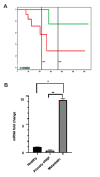Identification of CCNB2 as A Potential Non-Invasive Breast Cancer Biomarker in Peripheral Blood Mononuclear Cells Using The Systems Biology Approach
- PMID: 34455715
- PMCID: PMC8405074
- DOI: 10.22074/cellj.2021.7053
Identification of CCNB2 as A Potential Non-Invasive Breast Cancer Biomarker in Peripheral Blood Mononuclear Cells Using The Systems Biology Approach
Abstract
Objective: Breast cancer (BC) still remains an imperative clinical issue, despite advances in the diagnosis, prognosis and treatment modalities of this malignancy. Hence, progress has been made to identify non-invasive, high sensitive and specific biomarkers. Since immune system affects development of breast cancer, peripheral blood mononuclear cells (PBMCs) -a subpopulation of immune cells- can be considered as a promising tool in the field of BC biomarker research. In the current study, we initially attempted to use concept of the present shared biomarkers in solid tumors and systemic immune profile and then evaluate correlation of these biomarkers to clinical use in cancer research.
Materials and methods: In this experimental study, available microarray gene expression datasets of BC as well as the related PBMCs were retrieved and downloaded from the Gene Expression Omnibus (GEO) database, followed by analysis using GEO2R along with affylmGUI, a R-based package, to obtain differentially expressed genes (DEGs). Signature genes from 20 types of cancer were also applied to validate DEGs. Quantitative reverse-transcription polymerase chain reaction (qRT-PCR) was carried out to assess mRNA level of CCNB2 in PBMC of the BC patients and healthy subjects.
Results: DEGs analysis for the transcription profile of BC cells and PBMCs showed two shared targets, CCNB2 and PGK1. Validation with systems biology using reweighted 20 types of cancer signature genes revealed that CCNB2 is the only common target in BC and its related PBMCs, which was further validated by qRT-PCR implying a significant increase in the level of CCNB2 in the BC patients.
Conclusion: Results of this study demonstrated that PBMCs are affected by BC cells and CCNB2 may be of value as a diagnostic biomarker for breast cancer. However, verification would require future detailed experimental plans.
Keywords: Biomarker; Breast Cancer; Peripheral Blood Mononuclear Cell; Systems Biology.
Copyright© by Royan Institute. All rights reserved.
Conflict of interest statement
There is no conflict of interest in this study.
Figures




Similar articles
-
High Glycolytic Activity Signature Reveals CCNB2 as a Key Therapeutic Target in Triple-Negative Breast Cancer.Front Biosci (Landmark Ed). 2024 Aug 23;29(8):308. doi: 10.31083/j.fbl2908308. Front Biosci (Landmark Ed). 2024. PMID: 39206892
-
Identification of Seven Cell Cycle-Related Genes with Unfavorable Prognosis and Construction of their TF-miRNA-mRNA regulatory network in Breast Cancer.J Cancer. 2021 Jan 1;12(3):740-753. doi: 10.7150/jca.48245. eCollection 2021. J Cancer. 2021. PMID: 33403032 Free PMC article.
-
Identification and Validation of Stage-Associated PBMC Biomarkers in Breast Cancer Using MS-Based Proteomics.Front Oncol. 2020 Jul 24;10:1101. doi: 10.3389/fonc.2020.01101. eCollection 2020. Front Oncol. 2020. PMID: 32793473 Free PMC article.
-
[Screening core genes and cyclin B2 as a potential diagnosis, treatment and prognostic biomarker of hepatocellular carcinoma based on bioinformatics analysis].Zhonghua Gan Zang Bing Za Zhi. 2020 Sep 20;28(9):773-783. doi: 10.3760/cma.j.cn501113-20200818-00461. Zhonghua Gan Zang Bing Za Zhi. 2020. PMID: 33053978 Chinese.
-
Human peripheral blood mononuclear cells as a valuable source of disease-related biomarkers: Evidence from comparative proteomics studies.Proteomics Clin Appl. 2024 Mar;18(2):e2300072. doi: 10.1002/prca.202300072. Epub 2023 Nov 7. Proteomics Clin Appl. 2024. PMID: 37933719 Review.
Cited by
-
High expression of CCNB2 is an independent predictive poor prognostic biomarker and correlates with immune infiltrates in breast carcinoma.Heliyon. 2024 May 21;10(10):e31586. doi: 10.1016/j.heliyon.2024.e31586. eCollection 2024 May 30. Heliyon. 2024. PMID: 38831807 Free PMC article.
-
Network-based analysis of candidate oncogenes and pathways in hepatocellular carcinoma.Biochem Biophys Rep. 2025 Jun 10;43:102086. doi: 10.1016/j.bbrep.2025.102086. eCollection 2025 Sep. Biochem Biophys Rep. 2025. PMID: 40546347 Free PMC article.
-
Identification of hub genes and pathways in hepatitis B virus-associated hepatocellular carcinoma: A comprehensive in silico study.Health Sci Rep. 2024 Jun 17;7(6):e2185. doi: 10.1002/hsr2.2185. eCollection 2024 Jun. Health Sci Rep. 2024. PMID: 38895552 Free PMC article.
-
Upregulation of CCNB2 and Its Perspective Mechanisms in Cerebral Ischemic Stroke and All Subtypes of Lung Cancer: A Comprehensive Study.Front Integr Neurosci. 2022 Jul 19;16:854540. doi: 10.3389/fnint.2022.854540. eCollection 2022. Front Integr Neurosci. 2022. PMID: 35928585 Free PMC article.
References
LinkOut - more resources
Full Text Sources
Miscellaneous
